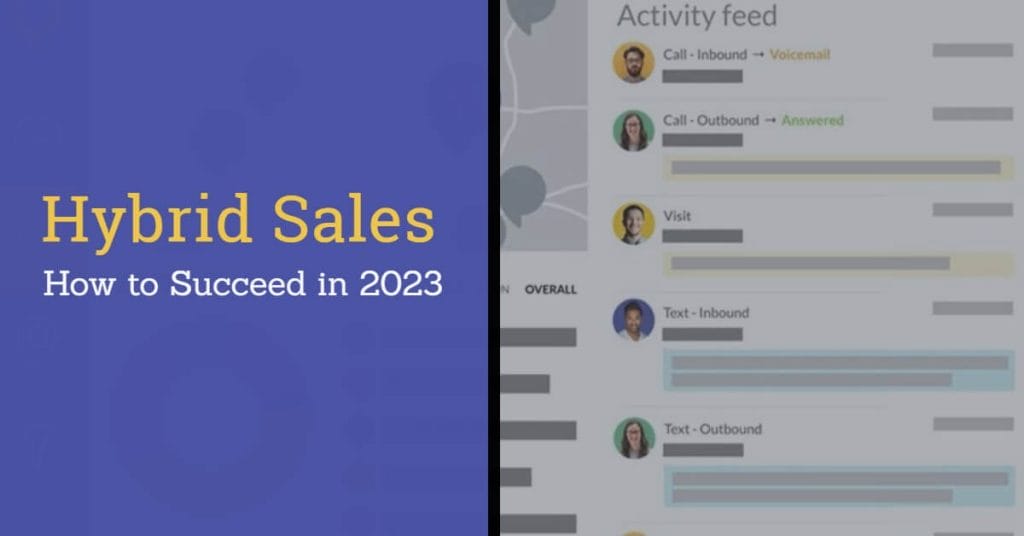It’s no secret technology and the pandemic has transformed how businesses communicate with customers and prospects. For many companies that relied heavily on outside selling this meant they had to adapt their processes to become more virtual while making face-to-face interaction more limited, but also more effective. In short, these companies were moving towards “hybrid sales”.
This article will dive deep into what Hybrid Sales means, the reasons you may consider going hybrid and the pros and cons of that decision, and even some helpful tips for how to make the change with your team.
Ready? Let’s go!
What is a hybrid sales model?
A hybrid sales model is a digital and in-person approach for B2B sales. This model caters to customers’ preference for digital or in-person interactions, providing sales leads with information about a product or service.
As we reflect on why this change has transformed through the previous years, we realize the impacts of COVID-19 on the sales industry. This has changed how sales leaders approach existing and potential customers and understanding just how they would like to be approached. The sales model as we knew it has been reshaped to its core compared to the traditional method we were used to, it has changed to a more remote and virtual engagement strategy.
This sales model is becoming more popular and is an excellent alternative to traditional sales. It’s thinking more about how the customer likes to buy and can be seen as a more profitable route and has been deemed successful for leaders in the industry. Although sales reps will need to rework traditional sales strategies, it’s believed that it may be more effective in the long run by appealing to their prospects’ way of making decisions.
In 2021, 60 percent of companies increased hybrid sales teams, and 62 percent added to their digital sales teams. These changes outpaced growth in more traditional sales roles, where increases also occurred, but at a slower rate. Companies say they expect these trends to continue into 2022 and beyond.
Why are more companies adopting a hybrid sales model?
The hybrid sales rep is how we’ll make b2b sales today and in the future, “85% of B2B organizations expect hybrid reps to be the most common sales role over the next three years”. It truly depends on the customer when it comes to how they prefer to purchase. That’s why having two different sales approaches works well when closing a deal.
“Similarly, B2B buyers are increasingly comfortable turning to digital and online channels to meet their purchasing needs. In fact, B2B buyers use up to and sometimes more than ten channels, including online and digital, as part of any given purchase, which is double the number of channels five years ago, and up from seven channels only two years ago.”
It’s been proven that times are changing with how we do business, and sales are a massive part of that. Climbing the hybrid learning curve will help sales leaders stay ahead of their competitors. With multiple ways of communicating now, it’s essential to be adaptive to that in sales. You must use multiple routes to find the preferred way your customer or prospect likes to be contacted. When this approach is made correctly, it makes for a smoother approach and closing process.
Hybrid sales are here to stay and will only get more popular with time. It’s changed how we do everything from business to our personal life. The pandemic changed a lot for us, and we must be pivot friendly in sales to stay competitive in the market.
Pro tip: Check out SPOTIO’s multi-channel software for a more convenient and an effective way to prioritize these cross-communication channels.
Pros & Cons of Using a Hybrid Model in Sales:
Pros:
More Positive Engaged Employees
- When your employees are highly engaged, it makes them more efficient while producing higher-quality work.
- They’re more likely to align with the team and overall business goals while taking on more accountability for their contribution.
Stronger Company Culture
- Building a solid company culture is crucial to your team’s success. It’s essential to survey your employees and communicate any challenges they may be experiencing. This will make them more open to feedback while giving them a voice to feel heard.
A More Efficient Working Environment
- Having software that helps organize tasks and employee communication is vital in setting your team up for success in an efficient working environment.
Lower Operational Costs
- Having fewer people in the office could mean reducing unused workspaces and gaining some financial benefits. You have more options with your space, and some companies might also choose just to rent a coworking space instead of an office. With more of a flexible work environment, you get plenty more options that could leave more money in your pocket.
Cons:
Harder to Collaborate with Remote Employees
- One of the leading drawbacks of remote work is the need for more effective communication that comes with not being in person with your team members consistently. With these everyday interactions lacking, building relationships becomes difficult to attain and reflect on the company’s foundation with things such as a strong work culture.
Quick Employee Burnout
- People have struggled with not feeling like they truly get a break from working from home, even with the hybrid model, almost feeling trapped in a way that can lead to feelings of burnout.
Overwhelming Hybrid Schedules
- Hybrid models can be exhausting for employees, with the demand and inconsistency of working from home and in the office. It’s been shown that going back and forth can put a lot of stress into employees’ lives.
Not Suitable for all Industries
- Not all industries can utilize the hybrid working model as effectively as others. Companies that need real-time supervision will certainly need onsite workers.
3 Tips to Increase Hybrid Sales Performance
Tip #1: Speak Your Customer’s Language
Hybrid sales are proving to be extremely effective. In fact, McKinsey found hybrid sales drive up to 50% more revenue by enabling broader, deeper customer engagement because of the ability to communicate across all available channels.
This is based on customers wanting to buy how they feel is convenient for their lifestyle. People want things done a certain way, rather than being forced to answer an email or someone knocking on their door. Each customer prefers a certain way of being communicated, and that’s why these first initial questions are so crucial before continuing the sales process.
McClure says, “When you start looking at hybrid selling, the customer is at the center of it. So you’ll want to build a customer-focused model. For instance, at Dropbox, we ask customers what their preferences are — we’ll say, ‘How can we best support your needs? How would you prefer to collaborate with us? Hybrid selling matches the way customers want to buy.’
Tip #2: Invest in the Right Tools
Adopting a new sales process requires new tools to ensure success, and hybrid selling isn’t any different. You need to invest time and money to learn the skills that are crucial to staying ahead of the game. This not only strengthens your sales efforts but your team as a whole. Investing in your team not only gives them a chance to close more deals by having a stronger foundation but also puts them ahead of the competition.
As McClure says, “Technology has become so important in a hybrid world. So investing in tools that support the model is critical. We’ve shifted the tools we use to enable a hybrid strategy and invested in technology that supports remote selling and sales team collaboration.”
Tip #3: Don’t Kill Outside Selling Entirely
Outside sales is just one of the many ways customers prefer to be communicated with; it’s not going anywhere any time soon. Outside sales teams are a big driver for hitting sales quotas. While technology allows us to “be” anywhere in the world at any time, there is no substitute for real-life one-on-one interaction. While it may not be the most popular way of closing a deal, it doesn’t mean it’s not the most fruitful option. In-person requests are 34 times more successful than those made over email. The close rate for in-person meetings is 40%. Executives and business travelers estimate that 28% of their current business would be lost without in-person meetings. With most things being digital nowadays, nothing can replace the value of having a conversation about a service or product in person, it’s simply unmatchable.
How to manage a hybrid sales team
Adopting a hybrid work model for your sales team introduces challenges, such as maintaining a community, staying relevant to cultural values, and ensuring your team stays productive toward the goals set.
Investing in ways of communication to ensure your team stays on track with goals and progress each day is important. Having more of a coaching style of management will be crucial to ensuring the team’s overall success with the hybrid model, they must buy into the vision and be aligned with where the team is going. Hiring people that are independently motivated and self-sufficient in sales, almost looking at their sales efforts as their own small business will be a strong quality on the team for people working in a hybrid model.
Key Takeaways
Whether you are interested in a hybrid model to respond to a change in the market or simply to try to educate yourself on what to expect, it’s essential to stay ahead of the curve by investing in the right tools to ensure your team’s success. In a remote-first world, the strategic advantage will go to the B2Bs that are quickest to take action. Staying pivot friendly in this industry is crucial to long-term success.
See How SPOTIO’s multi-channel software supports hybrid sales teams.
Let your reps smoothly manage their sales funnel from both the SPOTIO Mobile and Web apps. Provide your reps with a seamless hybrid experience for communicating through multiple channels within the SPOTIO product. Book a free demo of SPOTIO today.





